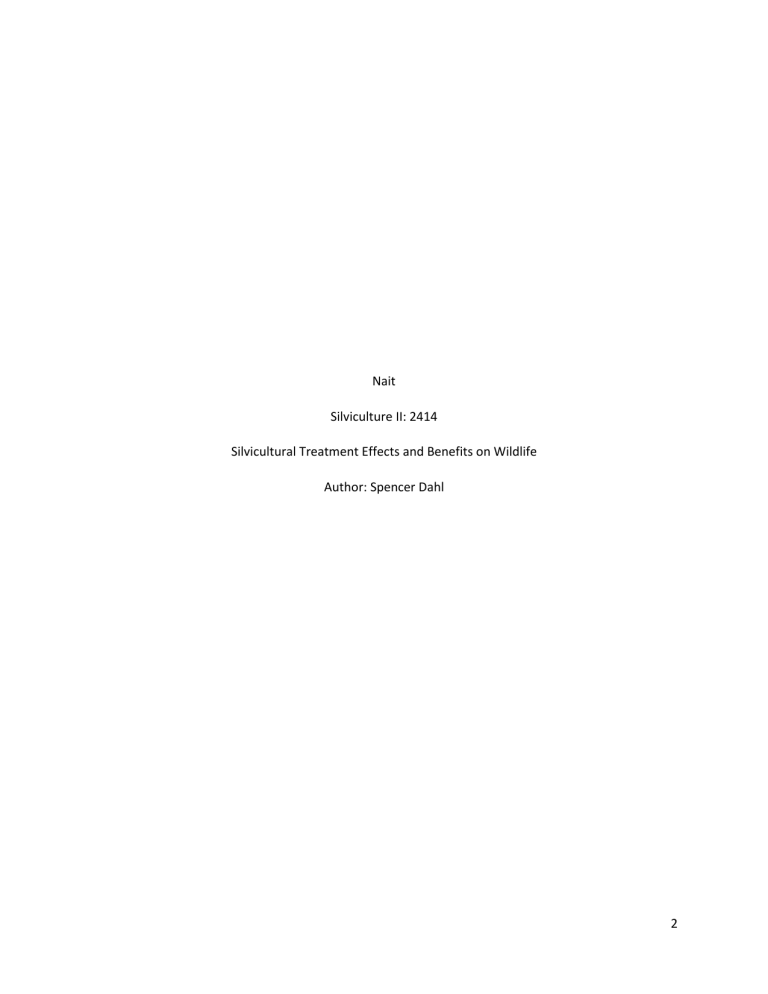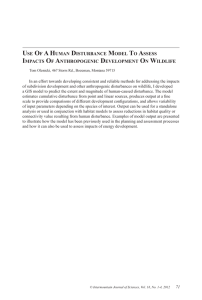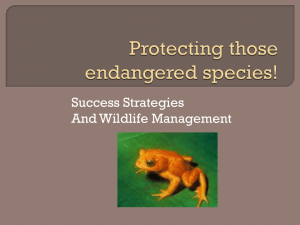
Nait Silviculture II: 2414 Silvicultural Treatment Effects and Benefits on Wildlife Author: Spencer Dahl 2 Contents Wildlife Response to Silviculture .................................................................................................................. 4 Clear cuts................................................................................................................................................... 4 Planting .......................................................................................Ошибка! Закладка не определена. Herbicide use ............................................................................................................................................ 5 Thinning .................................................................................................................................................... 5 Species at Risk in Alberta .............................................................................................................................. 6 Grizzly Bear ............................................................................................................................................... 6 Introduction .......................................................................................................................................... 6 Key Habitat Objectives .......................................................................................................................... 6 Methodology......................................................................................................................................... 7 Woodland Caribou .................................................................................................................................... 7 Introduction .......................................................................................................................................... 7 Key Habitat Objectives .......................................................................................................................... 7 Methodology......................................................................................................................................... 7 Citations ........................................................................................................................................................ 8 3 Wildlife Response to Silviculture Wildlife in any given area is affected by forestry, in return, silviculture and its practices are based on management practices and the extent of operations. Species receive negative and positive impacts from the impacts of forestry disturbance. Habitat loss for species that depend on older succession stages of forests, such as the Woodland Caribou. Many species depend on the short-lived, highly productive early-stage succession of a forested area. Management practices play a significant role in this for retention patches, dead-standing trees, erosion rates, etc. Clear cuts Clearcutting can benefit some species by increasing food availability, creating early successional habitat, and providing habitat diversification in the forested area. Removing all trees in a cut block opens the canopy allowing sunlight onto the forest floor, and promoting new plant species’ growth. Willow (Salix) grows best in full sunlight in moist, well-drained soils and comprises a large portion of a moose’s 50-80% diet-80%, ingesting different parts of the willow throughout the year. Moose and other browsing ungulates also eat assorted shrubs and high bush cranberries, which depend on large amounts of sunlight. Cut blocks are aimed to mimic fire disturbance resulting in early successional habitats from soon after disturbance. With the increase in fire suppression, there is still a need for these short lived, highly productive ecosites. 56 of the 60 mammal species commonly found in the Northeastern United States use early successional habitat, as well as many invertebrates, birds, and amphibians. These species depend on annual plants that produce an abundance of seeds that animals feed on and forbs and shrubs that require large amounts of sunlight. Reptiles also need heat sources from outside their body and benefit from the lack of a canopy. Birds that require open areas for hunting and woodpeckers that need dead standing trees for habitat are benefited. 4 Stocking The plantation of forestry industries is typically a monoculture of spruce or pine of the same age class and has a rotation age of approximately 80 years. A similar age class is expected in the boreal forest due to fire disturbance. The density of these plants is much higher than in a natural stand. The total stocking of white spruce is two times that of a natural spruce stand. With higher densities, the canopy will close earlier, suppressing the forage species. Herbicide use Herbicide application is a standard silviculture treatment prescribed to conifer plantations to remove the competition and give the conifer seedlings a chance to grow. Applications to the young forest have been shown to improve conditions for ground-foraging birds such as mourning doves and northern bobwhites. Removal of relatively unpalatable shrubs introduces the sprouting of palatable shrubs for ungulates such as whitetail deer. The herbicide reduces overall food sources on the site and cover needed by select species, making them more vulnerable to predation. Herbicide requires a small window of time application is acceptable considering wind, temperature, and precipitation. Bad practice and management could result in application outside of this perfect window and could have adverse effects in harming the surrounding stands and water quality. If herbicide is applied inappropriately, surrounding water courses are the most vulnerable; if leaching occurs, this can devastate the aquatic life present. Killing the vegetation, poisoning the fish, and considerable accumulation can pose toxicity to animals that drink the water. Thinning Thinning and selective timber harvest do a great job of capturing the different successional phases a forest goes through. By not clearcutting and instead selecting a few trees from a given area, this allows the stand to have both young and mature attributes such as lichen growth which is necessary for species such as the Woodland Caribou. The woodland caribou also depend on the cover provided by the forest to hide from predators and need forested corridors to find food and avoid predators. A commercially thinned stand allows for much more cover than clear cutting, making caribou food more abundant and making it easier not to be seen and accessed by predators. 5 The Bat community in Mississippi Alluvial Valley has responded positively due to the heterogeneous stand composition and increased insect biomass. The increase in deadwood, high basal area of large trees, high tree species diversification, and thinned gaps allow for unimpeded flights by bats. Bats with different species morphology, including their body and wing size, need different densities and ages of forests such as southeastern myotis and Rafinesque’s big-eared bat roost in large hollow trees within a dense canopy closure. The Evening bats and the Easter red Bats are more of a generalist species that forage in more open areas and near forest edges. Species at Risk in Alberta Grizzly Bear Introduction Grizzly bears’ habitat is an extensive range of mountains and foothills, and their diet consists of roots, berries, insects, rodents, and ungulates. Vegetation that grizzly bears consume varies in light dependencies and require both open areas with high sunlight and stands with a dense overstory and lower levels of sunlight. Increased human activity in grizzly bear habitat is the most significant contributor to the decline in population. This is due primarily to the increased access to these areas for recreation caused by forestry and oil and gas road networks. Site preparation activities should minimize ground disturbance as it minimizes regrowth in shrubs that rely heavily on sprouting, such as Vaccinium species. Key Habitat Objectives Since the grizzly habitat is so significant and their diet varies, the key objective is to have diversity present on the landscape and minimize human interference. Stocking is crucial as too dense of a canopy doesn’t allow for an understory to stay developed for extended periods; this limits the species of grizzly’s need for their diet. Especially important on south-facing slopes as in the spring, these areas are the first to melt and have plant life which is essential for grizzlies coming out of hibernation. Site preparation activities should minimize ground disturbance as it can severely harm species that rely on suckering for repopulation. 6 Methodology Commercial thinning is one of the best ways to promote grizzly bear habitat. This process puts gaps in the canopy that increases light on the understory. Promoting these diverse microclimates created by gaps in the canopy significantly increases forage throughout the stand creating a more productive and diverse understory. This aims to mimic a natural stand where gaps in the canopy are present due to the natural variability of age and wind fallen trees. The practice of limiting access to not promote recreational activities is also a great aim to support grizzly habitat. For site preparation, an exemplary method for grizzly habitat is a broadcast burn, which promotes berry species and enhances their yield. Coarse wood debris should be maintained and spread through the block to encourage ant colonies and rodents. Woodland Caribou Introduction Woodland caribou require an older growth forest and minimal disturbance. Lichen is a slow growing fungus that is the primary food source of this species, and with increased disturbance, it is becoming sparser. Large open areas are not helpful for the caribou population, making them more susceptible to predators. Key Habitat Objectives The main objective for caribou is to minimize disturbance and aim for old growth stands with conditions for lichen development. Old growth stands to have a variety of age classes present, and dying trees provide food for the lichen and provide a thermal advantage for caribou in the winter. Methodology To mimic old growth stands with minimal open areas would be ideal for the caribou population. Selective harvesting would be a good practice to promote the caribou habitat. The uninterrupted cover from predators creates an ecosystem in which lichen can thrive. Implementing wildlife corridors and retention patches, ideally with old growth present, would be an excellent approach to preserving caribou habitat in clearcutting. 7 Citations Burton, P. J., A. C. Balisky, L. P. Coward, S. G. Cumming, and D. D. Kneeshaw. 1992. The value of managing biodiversity. Forestry Chronicle 68(2): 225-237. Author links open overlay panel Lorraine P. Ketzler a, L. P., Mitchell, M., Menzel, M. A., Meadows, J. S., Loeb, S. C., Ketzler, L. P., Dodd, L. E., Bolker, B. M., Adams, M. D., Aldridge, H. D., Aust, W. M., Barclay, R. M., Bartoń, K., Betts, B. J., Burnham, K. P., Feldhamer, G. A., Fenton, M. B., Fournier, D. A., Fraser, E. E., … Kaiser, H. F. (2018, March 7). Bat community response to silvicultural treatments in bottomland hardwood forests managed for wildlife in the Mississippi alluvial valley. Forest Ecology and Management. Retrieved April 16, 2023, from https://www.sciencedirect.com/science/article/pii/S0378112717320285 Harlow, R. F., & Van Lear, D. H. (n.d.). Silvicultural effects on wildlife habitat in the south, an annotated bibliography, 1953-1979. Google Books. Retrieved April 10, 2023, from https://books.google.ca/books?hl=en&lr=&id=XtYrAQAAMAAJ&oi=fnd&pg=PA1&dq= silviculture%2Beffects%2Bon%2Bwildlife&ots=MZVJmXyUqm&sig=RfhKE7yoghrJNqgvnftF278TWg#v=onepage&q=silviculture%20effects%20on%20wildlife&f=false https://books.google.ca/books?hl=en&lr=&id=XtYrAQAAMAAJ&oi=fnd&pg=PA1&dq= silviculture+effects+on+wildlife&ots=MZVJmXyUqm&sig=RfhKE7yoghrJNqgvnftF278TWg#v=onepage&q&f=false Farrell, A. P., Tierney, K. B., & Brauner, C. J. (2013, December 3). Effects of herbicides on fish. Fish Physiology. Retrieved April 11, 2023, from https://www.sciencedirect.com/science/article/pii/B9780123982544000078 Waters, L., & Delong, R. (2001, June 4). Recruiting caribou habitat using silviculture treatments - gov. Retrieved April 11, 2023, from https://www.env.gov.bc.ca/wld/documents/caribou_silvi_treatments.pdf Graham, R., & Jain, T. (1998, December 16). Silviculture's role in managing boreal forests. Conservation Ecology. Retrieved April 11, 2023, from https://www.ecologyandsociety.org/vol2/iss2/art8/#SilviculturalSystemForSustainingPreda torHabitat Forests, M. of. (2022, January 20). Land based investment. Province of British Columbia. Retrieved April 16, 2023, from https://www2.gov.bc.ca/gov/content/environment/naturalresource-stewardship/land-based-investment 8 What is early successional habitat? What is Early Successional Habitat? (2022, June 2). Retrieved April 16, 2023, from https://dwr.virginia.gov/blog/what-is-early-successionalhabitat/ Agriculture and agri-Food Canada . (n.d.). Fish and wildlife habitat management bmpbooks.com. Retrieved April 17, 2023, from https://bmpbooks.com/media/Fish-andWildlife-Habitat-Management.pdf 9




